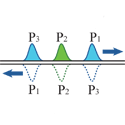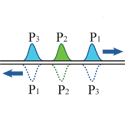Atomic middle man
Photons do not have direct interactions with each other. This reality has limited proposals for logic gates in all-optical quantum computing to probabilistic, rather than deterministic, operations. A notable exception was Duan and Kimble’s suggestion [1] that an atom in a cavity could mediate the interaction between successive photons. However, their scheme relied on laser pulses to manipulate the atom, which would have been technically difficult to implement in a scalable quantum circuit.
Now, in a clever variation of the Duan-Kimble scheme, Kazuki Koshino at the Tokyo Medical and Dental University, Satoshi Ishizaka at Hiroshima University, and Yasunobu Nakamura at NEC in Tsukuba, all in Japan, propose the first potentially workable, deterministic quantum gate that requires only a few single-photon pulses to operate. The gate, which Koshino et al. describe in a Rapid Communication in Physical Review A, works by swapping the states of an atom in a cavity and an incoming photon, and then carrying out a nontrivial entangling operation between the atom and a second incoming photon. A final swap with a third photon (which could be the same as the first) disentangles the atom and leaves photons 2 and 3 entangled. In short, the atom acts as a passive catalyst for interactions between single photons.
The energy requirements for this gate are, in principle, many orders of magnitude lower than for comparable gates that use atoms as qubits and strong laser fields as controls. The proposal could point a way to ultralow energy quantum computing, particularly if a solid-state quantum dot (which is easy to hold in place) serves as the atom. – Julio Gea-Banacloche
[1] L. M. Duan and J. H. Kimble, Phys. Rev. Lett. 92, 127902 (2004).





